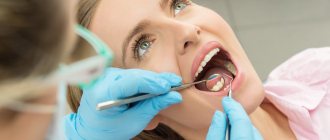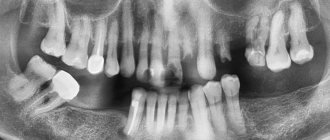Author of the article:
Soldatova Lyudmila Nikolaevna
Candidate of Medical Sciences, Professor of the Department of Clinical Dentistry of the St. Petersburg Medical and Social Institute, Chief Physician of the Alfa-Dent Dental Clinic, St. Petersburg
Pericoronitis is a popular dental disease that most often affects the gums of the lower jaw near the wisdom tooth. This is an inflammation of the gingival structures that occurs due to teething. The main thing is not to confuse periodontal disease. As a rule, the pathology occurs in people of older age groups and is accompanied by very unpleasant symptoms.
“Eight” is considered one of the most problematic teeth. Not surprisingly, these teeth appear later than all others, there is little space left for them. Therefore, often the wisdom tooth remains in the jaw without erupting. Sometimes the “figure eight” rests on neighboring teeth and cheeks, grows at an angle and causes a lot of unpleasant sensations.
Causes of pericoronitis
The disease most often results from:
- epithelial injuries due to difficult long-term tooth eruption;
- impacted (formed, but not erupted outward) teeth;
- atypically located tooth roots;
- thickening of the gum mucosa;
- accumulation of soft plaque under the hood and, accordingly, infection of tissues;
- reduction in the size of the dental arch, lack of space for teething;
The catalyst for pericoronitis of wisdom teeth is often a source of infection in the oral cavity. Very often the disease is provoked by caries, stomatitis or periodontitis. Sometimes the disease occurs against the background of ignoring the rules of personal hygiene, prolonged stress, hypovitaminosis and other conditions accompanied by decreased immunity.
Why does the gum around the wisdom tooth hurt?
The inflammatory process in the area of the third molar is always accompanied by swelling and pain. This allows you to notice it immediately and begin treatment in a timely manner. Before giving prescriptions to the patient, the dentist finds out the cause of the disorder. This is necessary to eliminate the infectious focus and prevent relapse.
Radiography is used to make the correct diagnosis. In the image, the doctor sees what is happening to the tissues and how far the inflammation has gone.
The main reasons look like this:
- wisdom tooth coming out;
- pericoronitis developed;
- a carious process occurs in the cervix.
Pain due to wisdom tooth cutting
Eights can appear both at 20 and at 50. And each case is a variant of the norm. You can never predict when these units will decide to show up. You can understand that a wisdom tooth is growing by the following signs:
- increase in gum volume;
- compaction and redness of tissues;
- pain when touching the inflamed area.
It happens that a unit does not cut through for a very long time. This is possible when the volume of bone structures is too large, there is insufficient space to accommodate a volumetric crown, or the unit is in a dystopic position (then it grows to the side or at an angle).
Pericoronitis as a cause of pain
The tissue surrounding the third molar may become inflamed. Plaque actively accumulates in the hole through which the figure eight erupts. A so-called gingival hood is formed. It does not allow the unit to “pass” completely and is a suitable place for the growth of bacteria and the accumulation of food debris.
Dental neck caries
The third molar has the same structure as the rest of the oral cavity, so caries on its surface is not uncommon. Then he hurts himself or the gums near him ache.
Due to the peculiarities of the position of the unit, a person usually does not have the opportunity to examine the carious cavity. Therefore, you should visit the dentist's office. Neglected caries leads to pulpitis. Then the treatment will be much more difficult.
Other reasons
Less common causes of discomfort in the figure eight area include:
- burn of mucous membranes;
- mechanical damage to tissues;
- hormonal imbalances, long-term use of hormonal medications, thyroid diseases;
- wearing incorrectly selected or low-quality removable dentures;
- stomatitis;
- gingivitis.
Symptoms of tooth pericoronitis
The main clinical manifestations of dental pericoronitis may be the following symptoms:
- swelling of the soft tissue of the gums in the area of the growing tooth;
- redness of soft tissues;
- pain that worsens when eating and brushing teeth;
- pain radiating to the temple, ear or eye socket (on the affected side);
- Difficulty opening the mouth and talking due to pain and swelling;
- bad breath;
- purulent discharge from under the gingival hood;
- increase in body temperature to 37.5 degrees.
If the disease has acquired a serious form, an increase in the submandibular and parotid lymph nodes (on the affected side) is observed, as well as a significant deterioration in the patient’s well-being.
Meanwhile, the most characteristic manifestations of wisdom tooth pericoronitis are:
- swelling of the gums;
- redness of the gums;
- pain in the gum area.
Often, with acute pericoronitis, the swelling is so severe that the patient has difficulty speaking and it becomes difficult to open and close his mouth.
Causes of the inflammatory process
Inflammation of the gums near the wisdom tooth is most often accompanied by pain and discomfort, so it can be quickly noticed and treated. Before prescribing a course of treatment, the dentist finds out the cause of the pathology in order to eliminate not only its symptoms, but also the source of infection.
To find out why your wisdom tooth hurts and your gums are swollen, you will have to take an x-ray. Only after collecting a medical history and x-raying the painful area does the dentist begin excision of gum tissue, tooth extraction or drug treatment.
In some serious diseases, for example, a cancerous tumor in the jaw, AIDS, removing a tooth without careful preliminary preparation for the operation is dangerous for a person’s life.
Difficulty erupting wisdom teeth
Most often, the gums around the wisdom tooth hurt due to pathologically incorrect eruption of the figure eight. The last molar in the dentition can take years to erupt due to:
- thickening of bone tissue;
- too large in size, due to which the tooth does not have enough space for full growth;
- dystopic position, in which the tooth grows incorrectly: horizontally or at an angle.
Variants of abnormal growth of wisdom teeth
Pericoronitis
When the last tooth in a row erupts slowly, a gum hood may form. It interferes with the further growth of the figure eight and is a convenient place for the accumulation of various food debris and saliva. As a result, harmful microorganisms begin to multiply in this hood.
If you notice pericoronitis at the initial stage of development, you can neutralize the inflammation with antibacterial drugs. If the pathology has developed into a purulent form, and the patient exhibits all the signs of general intoxication, doctors have to perform a small operation: excise the gum, removing the pus and helping the wisdom tooth to erupt.
Caries
The number eight has the same structure as the rest of the teeth, so it is susceptible to caries. In the presence of carious cavities, both the tooth itself and the gums around it can become inflamed and begin to hurt. In addition to caries, wisdom teeth are characterized by the formation of periodontitis and pulpitis.
Dental diseases of eights are detected during a visual or radiographic examination. The principle of their treatment depends on the number and size of carious cavities, the presence of antagonist teeth (paired third molars on the opposite jaw) and the general prognosis.
Typically, wisdom teeth affected by caries are removed. But in some cases they try to save them in order to use them as a support when installing removable dentures.
Other reasons
Inflammation of the gums around the eighth tooth can occur for the following reasons:
- mechanical injury or burn of gum tissue;
- hormonal changes in the body associated with pregnancy or menopause;
- pathologies of the thyroid gland;
- use of removable dentures;
- taking hormonal medications;
- throat diseases;
- diseases of the genitourinary system.
In addition to the reasons listed, the gums near the wisdom tooth may become inflamed due to gingivitis or stomatitis , which affects the oral mucosa.
Types of pericoronitis
Depending on the complexity and localization of inflammation, pericoronitis is divided into:
- Spicy.
The initial stage of the disease, which is characterized by pain, hyperemia and swelling of the gums. In case of acute pericoronitis of a wisdom tooth, there is no purulent discharge and the general condition of the patient does not suffer. With proper timely treatment, this type of disease disappears in 3-5 days.
- Ulcerative.
The disease develops against the background of epithelium damaged by fusospirochetes. A characteristic symptom of ulcerative pericoronitis is the appearance of a necrotic rim along the edges of the gums. Small ulcers form on the mucous membrane. When plaque is removed from the gum surface, bleeding begins.
- Purulent
Pericoronitis, as a rule, occurs in a subacute form and is manifested by severe pain. Pus is released from the source of inflammation, and the temperature rises. In the absence of timely treatment, the disease can provoke the formation of abscesses, phlegmon and periostitis.
- Posteriormolar.
The disease develops when molars erupt incorrectly. A gingival hood forms, which then becomes infected due to the active proliferation of bacteria.
Swelling of the gums due to periodontitis -
In case of poor-quality root canal treatment, due to tooth trauma, or in the absence of timely treatment of caries and pulpitis, inflammation occurs at the apex of the tooth root, which dentists call “periodontitis.” Sometimes the terms “granuloma” or “cyst” are used to refer to periodontitis, which you may well have heard. Such names are due to the fact that the focus of inflammation at the apex of the tooth root in these cases has the appearance of a purulent sac.
Symptoms - usually periodontitis has a chronic asymptomatic course, or there is only slight pain when biting on this tooth. But sometimes periods of exacerbation of inflammation occur, and in this case, acute pain may first occur in the causative tooth (especially when biting on it), and a little later, swelling of the gums usually appears in the projection of the causative tooth. But sometimes pain may be completely absent, and patients complain solely that the gums near the tooth are swollen (Fig. 1-3, 7-9).
Please note that with periodontitis, the source of inflammation is located at the apex of the tooth root, i.e. quite deep in the bone tissue. Therefore, swelling of the gums during periodontitis usually develops not just in the projection of the causative tooth, but most often in the projection of the apex of the root of the causative tooth. And in multi-rooted chewing teeth - no less often in the projection of the bone interradicular septum. But periodontitis is not characterized by swelling of the interdental papilla or the gingival margin adjacent to the neck of the tooth.
In general, if you have swelling on the gum in one of your teeth, pain occurs when you bite on it, and there is a crown, filling or carious destruction on the tooth, and also if, in addition to swelling on your gums, you also have swelling of soft tissues face (again in the projection of the causative tooth) - you can definitely make a diagnosis of “Exacerbation of chronic periodontitis.” An X-ray of this tooth will allow you to accurately determine the cause of periodontitis and the required amount of treatment.
What treatment may be required -
As we said above, if the gums are swollen and painful, then in most cases the reasons are poor-quality filling of the canals, or the lack of timely treatment of dental caries and pulpitis. Only according to official statistics, root canal fillings are performed poorly by dentists in at least 60-70% of cases. The main errors during treatment are underfilling of root canals, poor obturation of root canals with filling substances, breakage of instruments, perforation of the tooth root...
As a result of this treatment, a focus of purulent inflammation appears at the apex of the tooth root. Moreover, in the absence of timely treatment of the tooth for caries and pulpitis, exactly the same focus of inflammation will appear at the apex of the tooth root, but only against the background of unsealed root canals. In Fig. 10-12 you can see how the inflammation at the apex of the tooth root looks like during periodontitis (on the diagram, x-ray and on the root of the extracted tooth) -
Below we describe several treatment options that may be possible for patients with gum swelling due to dental periodontitis. In any case, the doctor will first be forced to take an x-ray. The image will allow us to determine whether this tooth can be saved at all, the size of the inflammatory focus at the apex of the root, and whether root canals have been filled in this tooth previously. The treatment tactics will depend on the latter, and below we will tell you how to cure a tooth and remove swelling from the gums so that it does not appear again.
1) If the channels are not sealed -
If root canal treatment has not previously been carried out on this tooth, then standard treatment of periodontitis is carried out with mechanical treatment of the root canals and treatment of the source of inflammation behind the root apex. On your first visit, they will open your tooth, expand the root canals to allow pus to drain out through them, and leave the tooth open for several days, prescribing antibiotics and anti-inflammatory therapy.
If necessary, your dentist may then refer you to an oral surgeon to make a small incision in the gum to allow additional drainage of pus. After about 3-5 days, the doctor makes an appointment for a second appointment and, if the inflammation subsides, completes the mechanical treatment of the root canals and seals them - either first with a temporary medicinal paste, or immediately with gutta-percha (the latter depends on the size of the source of inflammation at the apex of the tooth root). You can read more about the treatment of periodontitis at the link above.
How the gum incision is made - significant swelling of the gums, or if your gums and cheek are swollen at the same time - indicates the formation of a large purulent abscess, which will require not only opening the root canals of the causative tooth, but also making an incision in the gums to release the pus. The incision is made under local anesthesia, the wound is then washed with antiseptics and a drain is inserted into it (see video below).
2) If the channels are sealed poorly -
If an x-ray shows that canal treatment has already been carried out previously and the cause of inflammation was incomplete filling of the root canals to the apex of the tooth root, then there are 2 treatment options: either standard conservative therapeutic treatment, or an option associated with resection of the root apex.
- Conservative therapeutic treatment - on the first visit, the filling/artificial crown is removed from the tooth, poorly filled root canals are unsealed, washed with antiseptics, and antibiotics are prescribed.
If necessary, the patient is referred to a dental surgeon to make an incision along the gum. Thus, to the treatment we described in the previous section, only 1 point was added here (unsealing the root canals). Then everything is the same - after the inflammation subsides, temporary or permanent filling of the root canals is carried out. If the source of inflammation is small, the canals are usually filled immediately and permanently with gutta-percha, and a permanent filling is placed at the next visit. If the inflammation is large, the canals are sealed with temporary medicinal paste for 1-3 months, and a temporary filling is placed. And only after this time the canals are filled with gutta-percha + a permanent filling or crown is placed. - Resection of the root apex (Fig. 13) –
This surgical method is much simpler and much cheaper than conventional therapeutic treatment, and it allows you to avoid removing the crown from the causative tooth in order to unfill and reseal the root canals.
However, this method is only suitable for those teeth in which the root canal was poorly filled only at the very apex of the root (and throughout the rest of the length the canal should be filled normally). This simple surgical operation is carried out within 25-35 minutes and consists of cutting off the apex of the root with the unfilled part of the root canal using a drill. To do this, an incision is made along the gum and a flap of the mucous membrane is moved back to give access to the bone tissue in the projection of the apex of the tooth root. Next, a small hole is made in the bone with a drill, through which the apex of the root is cut off and removed from the wound along with the granuloma/cyst at the apex. The wound is sutured and antibiotics are prescribed. Pros: cheap, simple, no need to remove the crown and re-treat the tooth.→ How is root resection surgery performed?
Treatment of pericoronitis
Treatment by a dentist and surgeon should be aimed not only at eliminating the symptoms of the disease, but also at eliminating its causes. As a rule, for wisdom tooth pericoronitis, drug therapy and surgical intervention are used.
Drug treatment is the fight against microorganisms that caused the development of the infectious process. The doctor also prescribes medications that reduce pain and inflammation symptoms.
As a rule, the following groups of drugs are used to treat wisdom tooth pericoronitis:
- antiseptics, mouth rinses. The products reduce the microbial load and wash away bacterial and purulent particles.
- nonsteroidal anti-inflammatory drugs, for example, Ibuprofen, Ketorolac.
- antimicrobial, broad-spectrum anti-inflammatory drugs, for example, Amoxicillin, Amoxiclav, Azithromycin.
Surgical intervention for wisdom tooth pericoronitis usually involves excision (removal) of the gum hood over the wisdom tooth. This tactic is chosen in case of frequent relapses of the disease, pronounced pain syndrome, and spread of the purulent process to surrounding tissues. When an area of soft tissue is excised above the surface of the crown, plaque stops accumulating, which prevents infection and progression of the disease.
Excision of the hood takes no more than 10-15 minutes and is performed under local anesthesia.
If removing the hood and conservative treatment does not lead to an improvement in the condition, it is possible to remove the wisdom tooth. Removal is also carried out in case of incorrect tooth position or significant deviation of the “figure eight” from its physiological axis. In rare cases, not only the wisdom tooth is removed, but also part of the bone tissue. After removal, in almost 100% of cases, the patient recovers completely.
It is worth noting that many patients often insist on maintaining the “eight”. Many believe that in the future a wisdom tooth may be useful if prosthetics are needed. However, such an opinion is wrong. The wisdom tooth is located the farthest away and does not bear a significant functional load, taking only 2% of the total load on the dentition. When installing a crown, the wisdom tooth will not withstand the pressure, and the prosthesis will have to be replaced very soon.
Eruption of wisdom teeth: symptoms
The duration of symptoms of the eruption of a wisdom tooth will depend on the availability of sufficient space in the dentition for its eruption, as well as on the position of the tooth in the jaw. If there is not enough space for eruption, it can only partially erupt (for example, by one or several cusps of the crown part of the tooth). The tooth can remain in this state for many years and decades - until it moves the tooth in front and makes room for itself.
All this time, you may feel periodic discomfort, especially pronounced during periods of colds. Also, the cause of difficult eruption may be the incorrect orientation of the tooth in the jaw, for example, it may begin to erupt at a strong angle to the 7th tooth in front (resting against it with the cusps of the crown part). Unfortunately, this process will be accompanied not only by negative symptoms of teething, but will also lead to the gradual destruction of the crown of the 7th tooth.
Destruction of the crown of the 7th tooth during the eruption of a wisdom tooth –
Eighth teeth that have difficulty erupting (due to horizontal position or lack of space in the dentition) are usually called impacted. Dentists most often recommend removing such teeth to prevent displacement and crowding of the front teeth, or damage to the teeth in front. You can read more about the indications for deletion/saving at the link below.
→ Indications for wisdom teeth removal
Rinse
Special rinses will help relieve pain and swelling at home. However, such treatment is symptomatic. If inflammation progresses, in no case should you limit yourself to rinsing only.
The treatment for inflammation recommended by dentists is ASEPTA Active mouth rinse. This unique two-component product with a combination of “chlorhexidine + benzydamine” has an antimicrobial, anti-inflammatory effect and provides an immediate analgesic effect.
To eliminate inflammation and relieve discomfort during wisdom tooth pericoronitis, it is possible to use such medicinal herbs as:
- chamomile;
- sage;
- calendula.
How to relieve pain?
When visiting the clinic, the attending physician gives valuable recommendations that will help relieve the process of the “appearance” of the figure eight. If you decide to act on your own, you can use the following medicines and folk remedies.
Pills and medicines
- Tablets: “Nimesil”, “Analgin”, “Solpadein”, “Tempalgin”, “Ketanov”, “Paracetamol”, “Ibuprofen” are used according to the instructions.
- Gels and ointments: “Cholisal”, “Kamistad”, “Kalgel”, “Metrogil Denta” are applied to the site of tooth eruption.
- Solutions: “Chlorhexidine”, “Miramistin” and “Furacilin” are used for antiseptic treatment of the oral cavity.
Folk remedies
- Soda, saline or soda-salt solution - 1 teaspoon of product for 1 glass of warm water, stir until completely dissolved, rinse the problem area every 2 - 3 hours.
- Sage, calendula, plantain, St. John's wort - to prepare a decoction, pour 1 tablespoon of the product into 1 glass of boiling water, leave for 20 - 30 minutes, use for rinsing every 2 - 3 hours.
Home methods of pain relief will be effective if there are no serious problems with the eruption of the figure eight. If inflammation occurs, the tooth is rotten or very loose, then they will not help, but will only aggravate the problem, which will lead to the development of complications.
Wisdom teeth removal with 20% discount
Moscow
Possible consequences
Pericoronitis of the wisdom tooth in the lower jaw is a rather dangerous disease, ignoring which can lead to very unpleasant consequences.
Possible complications of the disease may be:
- abscesses, phlegmon of the vestibule of the mouth, buccal area;
- periostitis;
- osteomyelitis of the jaw;
- periodontitis;
- ulcerative stomatitis;
- actinomycosis;
- paradental cysts.
In addition, if wisdom tooth pericoronitis affects the lymph nodes, if inflammation develops, the lymphatic system may become a victim of infection.
And, of course, without proper treatment, the disease can become chronic and periodically “harass” the patient with unpleasant symptoms. Inflammation can spread to neighboring healthy teeth. Therefore, in order to avoid complications, treatment of the disease should be carried out as early as possible.
Prevention
As you know, it is easier to prevent a disease than to treat it. The main disease prevention measures are:
- annual dental examinations;
- timely diagnosis and treatment of impacted molars;
- maintaining oral hygiene;
- timely treatment of caries, gingivitis, periodontitis and other dental diseases;
- Regular (once every six months) professional teeth cleaning in a dental clinic.
Remember: pericoronitis without proper treatment can cause very serious complications. Therefore, if you suspect inflammation, do not delay your visit to the dentist. The doctor will help you cope with unpleasant sensations in a matter of days and prevent the development of the disease.
Clinical researches
Repeated clinical studies have proven that the two-component mouth rinse ASEPTA ACTIVE more effectively combats the causes of inflammation and bleeding compared to single-component rinses - it reduces inflammation by 41% and reduces bleeding gums by 43%.
Sources:
- The role of anti-inflammatory rinse in the treatment of periodontal diseases (L.Yu. Orekhova, A.A. Leontyev, S.B. Ulitovsky) L.Yu. OREKHOVA, Doctor of Medical Sciences, Prof., Head of Department; A.A. LEONTIEV, dentist; S.B. ULITOVSKY, Doctor of Medical Sciences, Prof. Department of Therapeutic Dentistry of St. Petersburg State Medical University named after. acad. I. P. Pavlova
- The role of hygiene products in the treatment of periodontal diseases (S.B. Ulitovsky Honored Doctor of the Russian Federation, Honored Dentist StAR Prof., Doctor of Medical Sciences, Department of Preventive Dentistry of Pavlov Pavlov State Medical University, St. Petersburg) S.B. Ulitovsky - Honored Doctor of the Russian Federation, Honored Dentist of StAR, Prof., Doctor of Medical Sciences; E.S. Alekseeva - associate professor, candidate of medical sciences; A.A. Vasyanina - associate professor, candidate of medical sciences; V.A. Grigoriev - Associate Professor, Ph.D.
- The use of drugs from the Asepta line in the complex treatment of inflammatory periodontal diseases (N.V. Berezina E.N. Silantyeva S.M. Krivonos, Kazan State Medical Academy. Kazan.) N.V. BEREZINA, E.N. SILANTIEVA, S.M. KRIVONOS Kazan State Medical Academy











